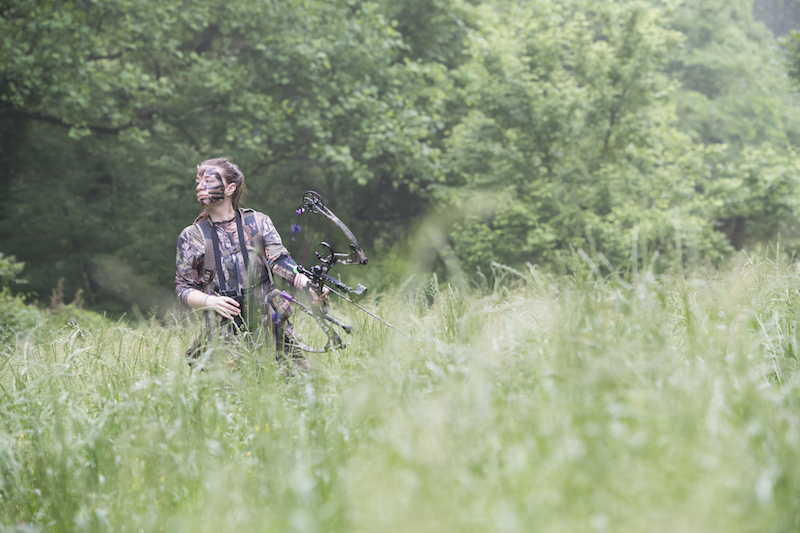If you like bowhunting deer, you’ll like bowhunting turkeys. These wary birds offer unique and challenging bowhunts few other quarry can match. Just ask Josh Webb from Moultrie, Georgia. He’s hooked on turkey hunting.
“If you’ve experienced the feelings of harvesting a deer with archery equipment, and the intensity of its adrenaline rush, it’s amplified with turkeys,” Webb said. “It’s the ultimate challenge. A turkey’s main defense is its eyesight, so hunting them from the ground and being really close to them is challenging and exciting.”
Webb has bowhunted 15 years, but he began bowhunting turkeys eight years ago, and has arrowed about 20 since. He also makes out-of-state bowhunts for long-beards each year to extend his season.
He encourages all bowhunters to add turkeys to their adventures, and offers a few tips to get started.

Practice making shots from a seated or kneeling position. Photo Credit: ATA
Hunting turkeys with a bow and arrow differs from bowhunting white-tailed deer. Bowhunters usually hunt deer from treestands, but they usually hunt turkeys while seated or kneeling, which is more difficult. Therefore, you must practice drawing and shooting while seated or kneeling. Experiment with shooting positions until you feel comfortable and can shoot with confidence. If you struggle to draw your bow while seated or kneeling, reduce your draw weight to something manageable.
You should also practice while wearing your bowhunting clothes and other gear. Get used to it while ensuring it’s quiet and won’t interfere with your shot. Most turkey hunters wear facemasks, for example, but if you dislike shooting with them, try camouflage face paint.
A turkey’s vital area, including its heart and lungs, is obviously much smaller than a deer’s. Webb said the turkey’s vitals are about the size of a grapefruit. Their location also differs, so check online images that show a gobbler’s vitals when it’s resting and strutting. The “Turkey Shot Placement” article on the Mathews Inc. website provides good images to help you learn where to aim for lethal shots.
Webb also suggests shooting 3D turkey targets, which outline the vitals. Shooting life-size 3D targets helps bowhunters understand shot placement and good shooting angles.
“The margin for error is small,” Webb said. “It’s awful to wound a bird. Turkeys don’t bleed a lot, and they’re hard to track, so it’s important to make a good shot.”

Scout out the areas with a high population and try to figure out the direction they tend to fly when they come down from their roost. Photo Credit: ATA
Webb said prehunt scouting and planning is essential for bowhunting because it helps you precisely position yourself to intercept gobblers. Gun hunters should also scout and plan their hunts, but they can shoot farther and don’t need as much cover.
“A gun hunter can go into an area, pick any tree to set up on, and shoot a turkey entering the general vicinity,” Webb said. “A bowhunter must find a bird’s exact travel route, and then shrubs or a brush pile that offer concealment, and enough room to draw their bow.”
That means scouting extensively before the season to learn how birds move about on the landscape. Trail cameras can support and supplement your scouting. Choose a spot with the right cover, and plan how you’ll execute your hunt. Ask yourself if the setup is ideal for mornings or evenings, and how you’ll reach it without spooking turkeys.
Webb said turkeys rarely stand still for long. That makes them challenging to shoot. The closer the shot, the better, so—where legal—use a decoy to lure turkeys into range. Place your decoy at a known distance to help pinpoint the distance. Webb tries to shoot turkeys when they’re 10 to 20 yards away, so he places his decoy at 8 to 10 yards.
The closer the turkey, however, the harder it is to draw your bow unseen. If you draw recklessly, you’ll spook the bird. Webb suggests drawing when you can’t see the bird’s eyes. Be patient and wait until a tree, decoy or the gobbler’s fan blocks its view.

Turkey hunting from a ground blind lets you get incredibly close to the turkeys while remaining hidden. Photo Credit: ATA
Webb encourages most beginner bowhunters to use a ground blind, which conceals the draw and other movements when turkeys get close.
“It’s significantly easier to hunt turkeys from a ground blind,” Webb said. “Unless you really feel motivated, don’t dive headfirst into running and gunning.”
Instead, choose a ground blind with enough room to draw your bow. Check its windows and clear the ground inside so you can move quietly. Don’t bowhunt without a blind until you’re ready for a much larger challenge.
For more bowhunting tips and strategies for turkeys, check out these Bowhunting 360 articles:
– Let’s Talk Turkey: How to Prep for Your First Turkey Hunt
– Turkey Hunting 101: A Bowhunter’s Guide to Chasing Gobblers
– Prepare for a Full Day of Turkey Hunting